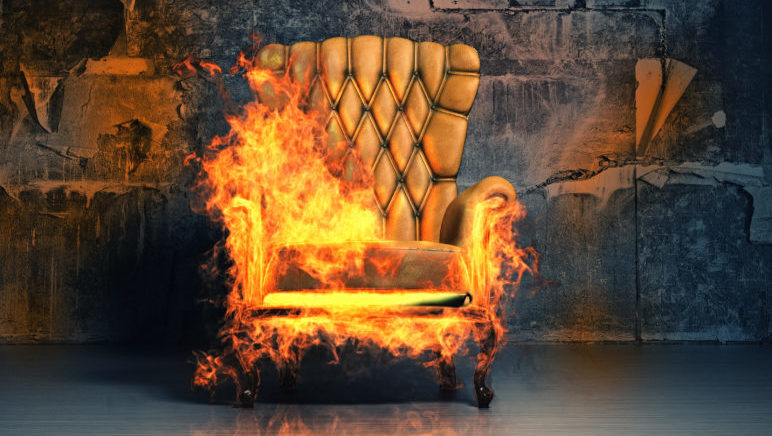Radio Law Talk Segment
Are the Chemicals in Your Furniture Protecting or Hurting You?
INTRO:
Rhode Island recently passed a law that bans flame retardants in furniture after environmental, health, and firefighter advocates voiced concerns that the chemicals in flame retardants contribute to increased cancer risks and other health issues.
FACTS (brief, 6 sentences):
Organohalogen flame retardants are organic compounds that are found in upholstered furniture and bedding to protect people and property from fire impact. However, flame retardants have been linked to a myriad of health concerns including increased cancer risk, decreased fertility, and even problems with child brain development. As such, Rhode Island recently passed a law that bans certain levels of organohalogen flame retardants in residential furniture and bedding. This law follows Maine’s recent ban on flame retardants in upholstered furniture just two months prior while Connecticut and Massachusetts are currently considering similar bills. While environmental and health advocates view Rhode Island’s new law as a success, the North American Flame Retardant Alliance (NAFRA) has spoken out against the law’s passage. Specifically, critics contend that this law will make furniture increasingly dangerous because it removes fire safety protections.
ISSUES (Summarize both sides argument, both perspectives. You can use bullet points):
- Should states, such as Rhode Island, pass laws to ban flame retardants in furniture?
- Yes:
- Flame retardants have been linked to health concerns including cancer and thyroid issues.
- Exposure to this chemical could increase firefighter cancer rates because firefighters are inhaling these chemicals on the job. When the chemical burns, resulting toxins can pose potentially severe breathing hazards. According to health and environmental advocates this chemical is dangerous to the nervous system.
- Other studies have linked flame retardants to a host of ailments including endocrine disruption, decreased fertility, and lower birth weights.
- Hannah Gardener, a researcher at the University of Miami, stated that regulations on fire retardants can protect children from brain development issues and increased cancer risks.
- Moreover, the chemicals from these products leach out of the products and infect people and pets. The chemicals can flake off of furniture and are easily inhaled. Even the dust people sweep up from their floor can contain toxic levels of flame retardants.
- According to Miriam Diamond, Professor of Geography, Chemical Engineering and Applied Chemistry at the University of Toronto, “There is a sufficient body of knowledge to conclude that all organohalogen flame retardants—because they are semi-volatile organic compounds—will tend to migrate out of the consumer products in which they are present in additive form, resulting in human exposure. The inevitability of this human exposure, combined with the evidence showing that these compounds have toxicity leads to the conclusion that all organohalogen flame retardants present in consumer products in additive form pose significant risks to human health.”
- On September 20th, the Consumer Product Safety Commission, a federal agency, voted to investigate how to limit organohalogens in consumer products. The Commission also voted to warn the public about the dangerous of organohalogens in household furniture.
- After receiving consumer concerns and state proposals, some companies have already removed the chemicals from their products. These companies include Ikea, Crate and Barrel, La-Z-Boy, and Macy’s.
- In 2000, Ikea banned brominated flame retardants in its furniture, and instead of adding chemical flame retardants, the company strives to use materials with inherent flame retardant properties such as natural wood.
- 14 states already have flame retardant restrictions on furniture, although these restrictions vary.
- Despite arguments that flame retardant chemicals save lives, firefighters have argued that smoke detectors and sprinklers are safer alternatives.
- No:
- According to the American Chemistry Council, flame retardants make furniture safer. Bryan Goodman, a spokesman for the council stated that these chemicals are important in providing protection during fires: “This law will remove a critical layer of fire protection and could increase the vulnerability of the citizens of Rhode Island when fires occur. The people of the state certainly understand well how devastating fires can be, given that 100 people were killed and 230 injured at the Station Nightclub in West Warwick in 2003.”
- Thomas G. Osimitz, a toxicologist and chair on the North American Flame Retardant Alliance (NAFRA) advisory council, argues that there is no scientific evidence of a link between fire retardants and long-term adverse health effects to firefighters. He also noted that the U.S. Environmental Protection Agency is assessing flame retardants. (potentially these bans are pre-mature)
- NAFRA critics include:
- Additive non-polymeric organohalogen flame retardants are a group of chemicals that are used in a number of products to help prevent them from catching fire. Certain types of these flame retardants can be used safely in specific applications while the U.S. Environmental Protection Agency has regulatory oversight of these chemicals.
- According to some Consumer Product Safety Commission experts, some additive, non-polymeric organohalogen flame retardants are not toxic while many health studies cannot be linked to specific products.
- Flame retardants serve different types of specific functions and should not be linked together broadly into one type of group.
- Yes:
LAW (with references, no need for blue book citations. This is the most important part, make sure the attorneys can answer any questions from callers on the topic. You can use bullet points):
- Rhode Island: H5082/ S0166: An Act Relating to Health and Safety – Child Products and Upholstered Furniture
- Beginning on July 1, 2019, no manufacturer, wholesaler, or retailer may manufacture, knowingly sell, offer for sale, or distribute for use in Rhode Island any residential upholstered bedding or furniture which contains a certain concentration of organohalogen flame retardant chemical.
- Specifically, the furniture cannot contain one hundred parts per million (100 ppm), or greater of this chemical.
- The ban includes any chemical containing the element bromine or chlorine bonded to carbon that is added to a plastic, foam, or textile.
- Manufacturers must notify persons or entities that sell the banned products in Rhode Island about the law at least 90 days prior to the effective date of the ban.
- The penalties for violating the law include up to a $5,000 civil fine for the first violation and up to a $10,000 fine for any violations thereafter.
- The director of the department of health is charged with enforcing these provisions.
- Rhode Island is the second state to ban these particular flame retardants, following Maine
- Maine Bill: LD 182: An Act to Protect Firefighters by Establishing a Prohibition on the Sale and Distribution of New Upholstered Furniture Containing Certain Flame-retardant Chemicals:
- Passed in August by Maine Legislators after the state Governor’s veto.
- Of the 14 states which have flame retardant restrictions on furniture, only Maine, who approved of a ban in August, will prohibit all flame retardants in upholstered furniture.
- Specifically, starting in 2019, a person can’t sell upholstered furniture whose material contains more than 1% of a flame-retardant chemical. However, these restrictions do not apply to used furniture.
- Connecticut and Massachusetts are considering similar bills
- In California, in 2013, Governor Jerry Brown revised Technical Bulletin 117 or TB 117. This law was first implemented in 1975 and required that materials such as polyurethane foam be used to fill furniture so that furniture would be able to withstand a small open flame for at least 12 seconds. However, a study by the California Environmental Protection Agency found that women in California had higher levels of toxic flame retardants in their breast tissue than other states and countries. Other studies also found that children in California had higher levels of flame retardant chemicals than children in other states. These studies prompted other investigations and a revision of TB 117. Under the revised law, TB 117-2013, and beginning in 2014, the law sets a new flammability test that furniture makers can meet without using flame retardant chemicals. Under this alternative test, known as the “smolder test,” manufacturers can line furniture with a fire shield or use flame-retardant fabrics which do not emit toxic gases, rather than injecting chemicals into upholstery foam.
DETAILED FACTS (tell the story):
On October 4, 2017, Rhode Island’s measure, S.0166, became law. The act was introduced by Senators Satchell, Coyne, Goldin, Archambault, and Sosnowski and was passed without a signature or veto from the state’s Governor, Gina Raimondo. The law bans organohalogan flame retardants in furniture, mattresses, and upholstered bedding that is manufactured by wholesalers or retailers in the state. Organohalogen compounds are a class of organic compounds that contain at least one compound bonded to carbon. The ban will begin July 1, 2019. Environmental advocates and firefighters advocated for passage of this new law because exposure to this chemical can be potentially dangerous. The passage of this law comes after two attempts by environmental advocates to pass a bill that bans these chemicals. The director of Clean Water Action, Johnathan Beard, attributes the success of this bill to the fact that environmental advocates joined with firefighters and first responders to pushing the ban on these chemicals.
OTHER FACTS (interesting facts, related facts, trivia, etc.):
ARTICLE LINKS (so we can print them out):
- https://www.bloomberglaw.com//exp/eyJpZCI6IjAwMDAwMTVlZThmNGQ0M2NhYjVlZmNmNjIzODAwMDAwIiwiY3R4dCI6IkJCTkEiLCJ1dWlkIjoiZFhwaEc4TllhZVByZDJpNGtQL3NNZz09Tkd1UUE4NjFRNUIvdUF0ZE1SbGJ3UT09IiwidGltZSI6IjE1MDcyMTY5NTgyNzEiLCJzaWciOiIwOUtpd1Z2dnJzOHY3NUVJOHMwWEpMZE04VGM9IiwidiI6IjEifQ==?emc=bnapslr:20
- http://webserver.rilin.state.ri.us/BillText/BillText17/SenateText17/S0166Aaa.pdf
- http://www.ikea.com/ms/en_KR/pdf/chemicals_and_Substances_en.pdf
- http://www.saferstates.org/toxic-chemicals/toxic-flame-retardants/
- https://earthjustice.org/features/scientists-quotes-organohalogen-flame-retardants
MEDIA (less than a 2 minutes FUNNY sound bite. You can include a couple of options. We realize that for some topics there is not much):




